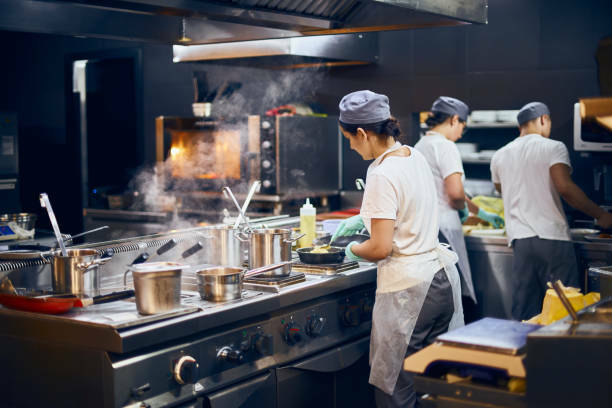What is the most important spot in any restaurant? Of course, it’s the kitchen. This is the place where the essential part of operations is performed and the main source of clients’ satisfaction and happiness. The success of your restaurant business depends greatly on how efficient you are in managing your kitchen. And managing a fully functional kitchen in a busy restaurant is no piece of cake. What are the factors every restaurateur should keep in mind when tackling the issue of kitchen management?
1. Hiring and managing your personnel
Your kitchen management process is going to depend greatly on the people working there. They are going to be your partners in kitchen management. That is why you should make a great effort hiring and training your personnel so they excel in doing their jobs every day.
Hiring process
Building your dream team requires following several steps.
- A background check should come as an obligatory step before you hire anyone. You will find out that lots of people change their jobs before it’s been one year of working at a certain restaurant. While this is a common practice in the industry, you should look into the reasons for this behavior by talking to each of your candidates and learning more about their personality traits. Anyway, your candidates’ skills and willingness to learn should probably come first in making your decision.
- Take your time to test their cooking skills and knowledge, but also look into their leadership and interpersonal skills. See how resilient they are to working under pressure and if they can easily adapt to changes.
Deciding on the number of staff
Having a sufficient number of people in your restaurant will help you avoid forming a stressful environment. You must have just the right headcount line cooks, servers, and maintenance personnel to help the chef and sous chefs do their job efficiently. Roles should be clearly defined between the employees so that all of them know exactly what they are responsible for.
Rotate your staff
It’s always better to work with people who are enthusiastic and willing to learn and try out new things. Employees tend to get burnt out easily if they are restricted to doing their respective functions only day after day. Encourage them to explore new things and learn to cook something outside their usual responsibilities. This way they might be able to fill in for one another in crises when things get out of control. For example, it’s always nice when your grill cook can prepare a sauce or a salad.
Provide personnel with the latest technology and equipment
- Employees will love their job if they have modern tools and technologies to help them. If you are familiar with the current tech trends in the restaurant business, this means you care about your employees and you want to make your workflow efficient. This includes smart cooking equipment and tools, as well as modern hardware and software to manage the business processes.
- You should have guidelines and policies in place providing all the details about your working process, and everything else that employees must learn after they are hired.
2. Scheduling Lifehacks
Scheduling is key to good restaurant management practices. The work in the kitchen always starts several hours before opening. The prep process is time-consuming, and it should always be kept in mind.
- Your working day should start much earlier than the restaurant begins serving clients. Start with briefing your head chef and sous chefs so they can pass the plan and instructions to their respective team members and start cooking. Take some time to reflect on the new customer feedback and think about how you can improve to make the outcome better. Ask for employees' insights on what changes they could introduce to reach more productivity.
- Run your prep sheet with all your employees. This is especially important if your policy is cooking everything from scratch. Your previous sales reports are the source of data and insights on how your prep sheet might be adjusted. You will find precise information on how much time is required for cooking certain dishes, and which members of your staff should be responsible for cooking them. If some members of your team have a scheduled leave for the upcoming week and decide who is going to replace them.
- The number of staff you will need every day will depend on the day of the week. Weekends are much busier in restaurants than Mondays. Therefore, you should plan your employees’ schedules accordingly, to keep the workflow steady. Employees time tracking functions of your restaurant management software will help you do this job appropriately.
- Run the information about your regular, special and seasonal dishes with your staff. Make note of the serving procedures with your wait crew. Make sure they remember details about your menu items to communicate the right information to the customers.
- Be ready to multitask when things get busy in your restaurant. A restaurant owner should be ready to step in and help his employees by performing some of the tasks. Help a bartender fix a drink for a client. Plate a dish that is ready to be sent to the customer’s table. If you act like a leader, this will encourage and inspire your personnel to do their best.
3. Tools and technology
Restaurant management systems are becoming more and more complex every year, with more processes to manage, automate and optimize. There are hundreds of tools in the market, helping to reduce the order processing time, automate redundant work, deliver a great customer experience, analyze profits & costs. Restaurant kitchen technology includes a Kitchen Display System that is integrated with a Point of Sale system. An efficient KDS digitizes Kitchen Order Tickets. When orders are entered into the system, they are displayed on the KDS. KDS not only provides information about your current orders but also gives you information on the previous orders and daily performance. It also sorts orders based on priority and cooking time. KDS connects your restaurant kitchen with the front-of-house.
4. Food safety and hygiene
Sanitation is a very important part of kitchen management. Messy and unclean kitchens are not pleasant to work in. A more organized and clean kitchen makes the personnel work efficiently. Once they enter the kitchen, they wouldn’t have to spend time scrubbing the pans and cookers before they start cooking. Cleanliness checks and sanitation audits are common practices in a restaurant kitchen. Here is the list of rules you should observe to avoid undesired outcomes.
- Exclude the possibility of contamination of the products you are purchasing for your restaurant kitchen. Each member must be aware of the safety measures.
- Make a checklist with the cleaning task assigned to the relevant members of the staff. Make sure it is properly maintained.
- Run your surprise audits to ensure the neatness and attentiveness of the kitchen staff.
- Assign a supervisor to check on the food preparation process in the kitchen.
Want more tips on running your restaurant business? Read more articles on Tawreed blog. Be sure to contact us if you are looking for reliable suppliers for your restaurant.




